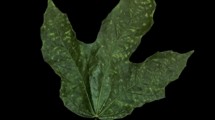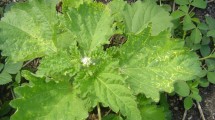Abstract
Begomoviruses have been detected infecting the weed Cnidoscolus urens (family Euphorbiaceae) since 2004, but the viral species to which these viruses belonged was not known. Here, we report for the first time the complete genome sequence of a bipartite begomovirus obtained from C. urens collected in the state of Alagoas, Brazil. This isolate met the criteria to be classified as a member of a new begomovirus species, and the tentative name cnidoscolus mosaic leaf deformation virus (CnMLDV) is proposed. Pairwise sequence comparisons and phylogenetic analysis showed that the DNA-A genomic component of CnMLDV is most closely related to that of passionfruit severe leaf distortion virus, with 86.3 % nucleotide sequence identity.
Similar content being viewed by others

Avoid common mistakes on your manuscript.
Begomovirus (family Geminiviridae) is a genus of plant viruses that have circular ssDNA genomes packaged in twinned quasi-icosahedral particles and are transmitted by the whitefly Bemisia tabaci [1]. Begomoviruses are considered a limiting factor for production of economically important crops worldwide, especially in tropical and subtropical regions [2, 3]. They are also able to infect a wide range of weed/non-cultivated plants, which can act as alternate hosts when cultivated plants are absent, or as a source of new begomoviruses that emerge via recombination in cases of mixed infection [4, 5].
Previous studies have focused on the diversity of begomoviruses infecting weed plants from the family Euphorbiaceae, and several begomoviruses have been reported, including euphorbia mosaic virus [6], croton yellow vein mosaic virus [7], euphorbia yellow mosaic virus (EuYMV) [8], dalechampia chlorotic mosaic virus [9], and jatropha mosaic virus [10]. In Brazil, EuYMV has been reported to cause mosaic disease in Euphorbia heterophylla since the 1950s [11] in addition to being found naturally infecting Macroptilium atropurpureum, Sida santaremensis, Crotalaria juncea and Solanum lycopersicum [4, 12, 13]. To date, EuYMV is the only begomovirus infecting euphorbiaceous hosts in Brazil that has been completely characterized [8]. In 2006, begomovirus infection in Cnidoscolus urens (family Euphorbiaceae) was reported [14], with plants displaying symptoms of yellow mosaic and leaf deformation. However, the genome sequence of this viral isolate is still unknown. Here, the full-length genome sequence of a new begomovirus infecting C. urens is reported.
In 2015, a sample of C. urens showing symptoms of mosaic and leaf deformation (Fig. 1A) was collected in the county of Messias, Alagoas State, Brazil. Total DNA was extracted from fresh leaves according to Doyle and Doyle [15]. DNA was used as a template for rolling-circle amplification (RCA) of the full-length begomovirus genomes [16]. The RCA products were individually cleaved with ApaI or HindIII restriction enzymes (Invitrogen™, ThermoFisher Scientific) and ligated into the pBluescript KS+ (Stratagene) plasmid vector, which had been cleaved with the same enzyme. Viral inserts were sequenced commercially by primer walking at Macrogen Inc.
The complete begomovirus genome was assembled using CodonCode Aligner v. 4.1.1 (http://www.codoncode.com). The DNA-A and DNA-B nucleotide sequences were initially analyzed using the BLASTn algorithm [17] and the GenBank non-redundant nucleotide sequence database to identify the viruses with which they shared greatest similarity. The most similar sequences from GenBank were then used to classify the novel isolate using the program Sequence Demarcation Tool v. 1.2 [18].
Multiple sequence alignments were made for the full-length DNA-A and DNA-B datasets using the MUSCLE algorithm [19]. Bayesian inference was run using MrBayes v. 2.3.3 [20] through the CIPRES web portal [21]. The best nucleotide substitution model was determined using MrModeltest v. 2.3 [22] according to the Akaike Information Criterion (AIC). The evolutionary model GTR+G+I was used for both the DNA-A and DNA-B datasets. Two replicates with four chains each for 10 million generations and sampling every 1000 generations were used (a total of 10,000 trees). The first 2,500 trees were discarded as a burn-in phase. Posterior probabilities [23] were determined from a majority-rule consensus tree generated with the 7,500 remaining trees. The trees were edited in the Figtree program v. 1.4 (ztree.bio.ed.ac.uk/software/figtree).
In order to perform recombination analysis, full-length DNA-A and DNA-B sequences identified during this study and reference sequences for begomoviruses from Brazil and other countries in Central and South America (Supplementary Table S1) were used. Identification of putative parents and recombination breakpoints was performed using Recombination Detection Program (RDP) v. 4 [24]. Recombination events detected by at least four different methods were considered reliable.
Complete sequences of two different clones were obtained from the same sample of C. urens: DNA-A and DNA-B clones (KT966771 and KT966772), represented by the isolate BR-Mes3-15. Using pairwise comparisons of DNA-A sequences and the ≥91 % nucleotide identity criterion established by the Geminiviridae Study Group of the International Committee on Taxonomy of Viruses [25], this isolate was classified as a new begomovirus (Fig. 1B). The virus reported here was most closely related to passionfruit leaf distortion virus (PSLDV; 86.3 % identity for the complete DNA-A), and shared only 72.8 % of nucleotide sequence identity with EuYMV (a begomovirus commonly found in euphorbiaceous hosts). DNA-B showed the highest nucleotide sequence identity (71.8 %) to an isolate of tomato mottle leaf curl virus (ToMoLCV, JF803264). The name cnidoscolus mosaic leaf deformation virus (CnMLDV) is proposed for this new begomovirus.
The genome of CnMLDV contained five ORFs in the DNA-A and two in the DNA-B (data not shown). The cognate DNA-A and DNA-B components had the conserved nonanucleotide (5’-TAATATT/AC-3’) at the origin of replication, three identical iterons (TGGGGTC) located upstream from the Rep TATA box, and shared 97.3 % nucleotide sequence identity in the common region (CR, 185 nt). The Bayesian phylogenetic tree based on the DNA-A sequences placed CnMLDV in a same cluster with the PSLDV isolate, reinforcing their genetic relationship (Fig. 2A). The CnMLDV DNA-B clustered apart from PSLDV, in agreement with the SDT analysis, where they shared only 69.2 % nucleotide sequence identity (Fig. 2B).
RDP4 analysis revealed evidence of a single recombination event occurring in the DNA-A of CnMLDV, with putative recombination breakpoints located in the CR and REn (Supplementary Table S2). ToMoLCV, a begomovirus commonly found infecting tomato plants in northeastern Brazil [26], was identified as the putative major parent, with the minor parent being unknown. For the CnMLDV DNA-B, one recombination event with putative recombination breakpoints located in the CR was detected, with macroptilium yellow net virus as the putative major parent (Supplementary Table S2). Although RDP4 analysis is unable to determine the actual sequence of the parents, it seems that begomoviruses infecting cultivated hosts have contributed to CnMLDV emergence/evolution. Together, these results support the classification of CnMLDV as a member of a distinct species in the genus Begomovirus, reinforcing the idea that non-cultivated/weed plants are natural reservoirs of genetic diversity in this viral group.
References
Brown JK, Fauquet CM, Briddon RW, Zerbini FM, Moriones E, Navas-Castillo J (2012) Family Geminiviridae. In: King AMQ, Adams MJ, Carstens EB, Lefkowitz EJ (eds) Virus taxonomy. Ninth Report of the International Committee on Taxonomy of Viruses. Elsevier/Academic Press, London, pp 351–373
Morales FJ (2010) Distribution and dissemination of begomoviruses in Latin America and the Caribbean. In: Stansly PA, Naranjo SE (eds) Bemisia bionomics and management of global pest. Springer, Berlin, pp 283–318
Navas-Castillo J, Fiallo-Olivé E, Sánchez-Campos S (2011) Emerging virus diseases transmitted by whiteflies. Annu Rev Phytopathol 49:219–248
Barreto SS, Hallwass M, Aquino OM, Inoue-Nagata AK (2013) A study of weeds as potential inoculum sources for a tomato-infecting begomovirus in Central Brazil. Phytopathology 103:436–444
Rocha CS, Castillo-Urquiza GP, Lima ATM, Silva FN, Xavier CAD, Hora-Júnior BT, Beserra-Júnior EA, Malta AWO, Martin DP, Varsani A, Alfenas-Zerbini P, Mizubuti ESG, Zerbini FM (2013) Brazilian begomovirus populations are highly recombinant, rapidly evolving and segregated based on geographical location. J Virol 87:5784–5799
Hernández-Zepeda C, Idris AM, Carnevali G, Brown JK, Moreno-Valenzuela OA (2007) Molecular characterization and experimental host range of Euphobia mosaic virus-Yucatan Peninsula a begomovirus species in the Squash leaf curl virus. Plant Pathol 56:763–770
Hussain K, Hussain M, Mansoor S, Briddon RW (2011) Complete nucleotide sequence of a begomovirus and associated betasatellite infecting croton (Croton bonplandianus) in Pakistan. Arch Virol 156:1101–1105
Fernandes FR, Albuquerque LC, Oliveira CL, Cruz ARR, Rocha WB, Pereira TG, Naito FYB, Dias NM, Nagata T, Faria JC, Zerbini FM, Aragão FJL, Inoue-Nagata AK (2011) Molecular and biological characterization of a new Brazilian begomovirus, euphorbia yellow mosaic virus (EuYMV), infecting Euphorbia heterophylla plants. Arch Virol 156:2063–2069
Fiallo-Olivé E, Chirinos DT, Geraud-Pouey F, Moriones E, Navas-Castillo J (2013) Complete genome sequences of two begomoviruses infecting weeds in Venezuela. Arch Virol 158:277–280
Simmonds-Gordon RN, Collins-Fairclough AM, Stewart CS, Roye ME (2014) First report of a complete genome sequence for a begomovirus infecting Jatropha gossypifolia in the Americas. Arch Virol 159:2815–2818
Costa AS, Bennett CW (1950) Whitefly-transmitted mosaic of Euphorbia prunifolia. Phytopathology 40:266–283
Tavares SS, Ramos-Sobrinho R, González-Aguilera J, Lima GSA, Assunção IP, Zerbini FM (2012) Further molecular characterization of weed-associated begomoviruses in Brazil with an emphasis on Sida spp. Planta Daninha 30:305–315
Silva SJC, Castillo-Urquiza GP, Hora-Júnior BT, Assunção IP, Lima GSA, Pio-Ribeiro G, Mizubuti ESG, Zerbini FM (2012) Species diversity, phylogeny and genetic variability of begomovirus populations infecting leguminous weeds in northeastern Brazil. Plant Pathol 61:457–467
Assunção IP, Listik AF, Barros MCS, Amorim EPR, Silva SJC, Silva IO, Ramalho-Neto CE, Lima GSA (2006) Diversidade genética de Begomovirus que infectam plantas invasoras na região nordeste. Planta Daninha 24:239–244
Doyle JJ, Doyle JL (1987) A rapid DNA isolation procedure for small quantities of fresh leaf tissue. Phytochem Bull 19:11–15
Inoue-Nagata AK, Albuquerque LC, Rocha WB, Nagata T (2004) A simple method for cloning the complete begomovirus genome using the bacteriophage φ29 DNA polymerase. J Virol Methods 16:209–211
Altschul SF, Gish W, Miller W, Myers EW, Lipman DJ (1990) Basic local alignment search tool. J Mol Biol 215:403–410
Muhire B, Varsani A, Martin DP (2014) SDT: a virus classification tool based on pairwise sequence alignment and identity calculation. PLoS One 9:1–8
Tamura K, Peterson D, Peterson N, Stecher G, Nei M, Kumar S (2011) MEGA5: Molecular evolutionary genetics analysis using maximum likelihood, evolutionary distance, and maximum parsimony methods. Mol Biol Evol 28:2731–2739
Ronquist F, Teslenko M, van der Mark P, Ayres D, Darling A, Hönah S, Larget B, Liu L, Suchard MA, Huelsenbeck JP (2012) MrBayes 3.2: efficient Bayesian phylogenetic interference and model choice across a large model space. Syst Biol Adv Access 61:539–542
Miller MA, Holder MT, Vos R, Midford PE, Liebowitz T, Chan L, Hoover P, Warnow T (2010) The CIPRES portals. CIPRES. http://www.phylo.org/sub-sections/portal. Accessed 20 Nov 2015
Posada D, Buckley TR (2004) Model selection and model averaging in phylogenetics: advantages of Akaike information criterion and Bayesian approaches over likelihood ratio test. Syst Biol 53:793–808
Rannala B, Yang Z (1996) Probability distributions of molecular evolutionary trees: a new method of phylogenetic inference. J Mol Evol 43:304–311
Martin DP, Murrell B, Golden M, Khoosal A, Muhire B (2015) RDP: detection and analysis of recombination patterns in virus genome. Virus Evol 1:1–5
Brown JK, Zerbini FM, Navas-Castillo J, Moriones E, Ramos-Sobrinho R, Silva JCF, Fiallo-Olive E, Briddon R, Hernandez-Zepeda C, Idris A, Malathi V, Martin DP, Rivera-Bustamante R, Ueda S, Varsani A (2015) Revision of Begomovirus taxonomy based on pairwise sequence comparisons. Archives of Virology 160:1593–1619
Albuquerque LC, Varsani A, Fernandes FR, Pinheiro B, Ferreira PTO, Lemos TO, Inoue-Nagata AK (2012) Further characterization of tomato-infecting begomoviruses in Brazil. Arch Virol 157:747–752
Acknowledgments
R.R.S. was the recipient of a CAPES postdoctoral fellowship.
Author information
Authors and Affiliations
Corresponding author
Ethics declarations
Conflict of interest
The authors declare that they have no conflict of interest.
Electronic supplementary material
Below is the link to the electronic supplementary material.
Rights and permissions
About this article
Cite this article
Melo, A.M., Silva, S.J.C., Ramos-Sobrinho, R. et al. Cnidoscolus mosaic leaf deformation virus: a novel begomovirus infecting euphorbiaceous plants in Brazil. Arch Virol 161, 2605–2608 (2016). https://doi.org/10.1007/s00705-016-2919-3
Received:
Accepted:
Published:
Issue Date:
DOI: https://doi.org/10.1007/s00705-016-2919-3





